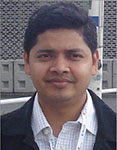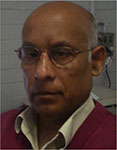Induced and natural fracture interaction in tight-gas reservoirs
Mohammad Rahman A and Sheik Rahman BA Australian School of Petroleum, The University of Adelaide
B School of Petroleum Engineering, The University of New South Wales
The APPEA Journal 52(1) 611-626 https://doi.org/10.1071/AJ11050
Published: 2012
Abstract
This paper investigates the interaction of an induced hydraulic fracture in the presence of a natural fracture and the subsequent propagation of this induced fracture. The developed, fully coupled finite element model integrates a wellbore, an induced hydraulic fracture, a natural fracture, and a reservoir that simulates interaction between the induced and natural fracture.
The results of this study have shown that natural fractures can have a profound effect on induced fracture propagation. In most cases, the induced fracture crosses the natural fracture at high angles of approach and high differential stress. At low angles of approach and low differential stress, the induced fracture is more likely to be arrested and/or break out from the far-end side of the natural fracture. It has also been observed that the propagation of the induced fracture is stopped by a large natural fracture at a high angle of approach, when the injection rate remains low. At a low angle of approach, the induced fracture deviates and propagates along the natural fracture. Crossing of the natural fracture and/or arrest by the natural fracture is controlled by the shear strength of the natural fracture, natural fracture orientation, and the in situ stress state of the reservoir.
In tight-gas reservoir development, the optimum well spacing and induced hydraulic fracture length are correlated. Therefore, fracturing design should be performed during the initial reservoir development planning phase along with the well spacing design to obtain an optimal depletion strategy. This model has a potential application in the design and optimisation of fracturing design in unconventional reservoirs including tight-gas reservoirs and enhanced geothermal systems.

Dr Mohammad Rahman received his PhD from the School of Petroleum Engineering at UNSW in 2010. He held positions as a process engineer, and served the petroleum industry in Asia for more than three years, before joining UNSW in 2007. His research interests include petroleum geomechanics, hydraulic fracture treatment design in naturally fractured reservoirs (mainly shales and other unconventional resources), geological sequestration of CO2, and geothermal heat extraction. His main research focus is on the stimulation techniques of fractured reservoirs (unconventional shale gas reservoirs), determining the effects of fluid injection on deformation, seal integrity and fault and fracture stability, stress and pore pressure coupling, and the development of numerical reservoir models. His work has been published more than four scientific papers in areas related to hydraulic fracturing. He has developed a technique using finite element method (FEM) modelling to investigate fracture interaction in tight-gas and unconventional reservoirs. mm.rahman@asp.adelaide.edu.au |

Professor Sheik Rahman received his PhD from the Institute of Petroleum Engineering at the Technical University of Clausthal (Germany) in 1984, held positions as a specialist drilling and production engineer, and served the petroleum industry in the Middle East, Europe and Asia for more than 12 years before joining the School of Petroleum Engineering at UNSW in 1989. His research interests include borehole stability analysis, hydraulic fracture treatment, and well drilling and completion of geothermal energy from hot dry rock and gas from coal-bed methane. His work has been published in more than 50 scientific papers in areas related to drilling, and he has co-authored a textbook on casing design. He has developed and taught more than 25 industrial training courses in Asia, Europe and Australia. He is an active member of the program committee of the SPE-IADC Asia Pacific Conference and plays an important role in developing strategic planning and direction for the SPE-IADC programs. sheik.rahman@unsw.edu.au |


